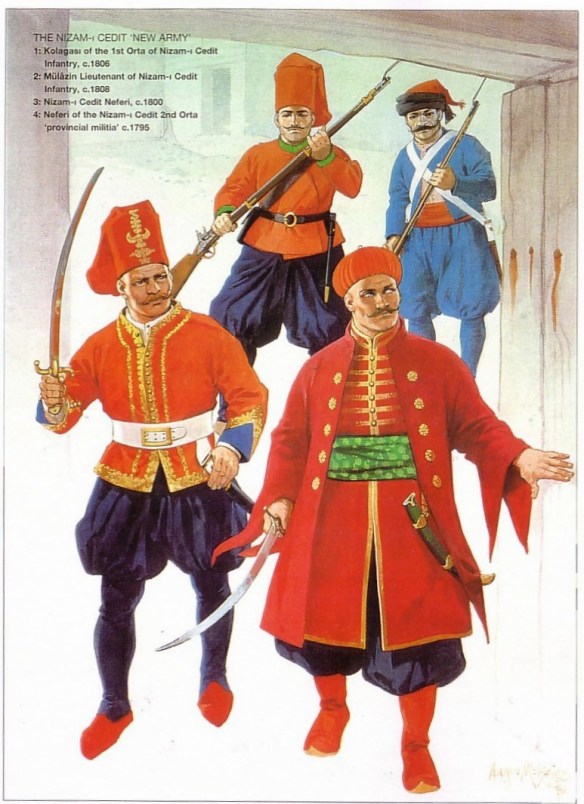Ottoman Army Early 19th Century.
1878 plan of the fortress of Silistra on the Danube, which was occupied, after several attempts, the Russians during the Russo-Turkish War of 1806-12.
PRINCIPAL COMBATANTS: Russia (with British alliance) vs. Ottoman Empire (with French alliance)
PRINCIPAL THEATER(S): Moldavia, Wallachia (Romania) and waters off Constantinople
DECLARATION: Ottoman Empire on Russia, November 6, 1806
MAJOR ISSUES AND OBJECTIVES: Russia and the Ottomans contended for control of Moldavia and Wallachia.
OUTCOME: The war ended indecisively, by means of a British-mediated peace; Moldavia and Wallachia remained under Ottoman control, but Russia gained Bessarabia.
APPROXIMATE MAXIMUM NUMBER OF MEN UNDER ARMS: At Batin (September 7, 1810) Russia fielded 22,000 against 35,000 Turks.
CASUALTIES: At Batin, Russia lost 2,000 killed or wounded, Turkey 5,000 killed or wounded and 5,000 captured.
TREATIES: Armistice of 1807; Treaty of Bucharest, May 28, 1812
France, locked in combat with Russia during the NAPOLEONIC WARS, took every opportunity to weaken its opponent. The French ambassador to the Ottoman Empire encouraged Sultan Selim III (1761-1808) to declare war on Russia because of its interference with Ottoman affairs in Moldavia and Wallachia. The declaration came on November 6, 1806, prompting Russia to invade Moldavia and Wallachia. However, the first major battle-indeed, the most important engagement of the war-came not on land but at sea. The Battle of Lemnos (or Athos) took place on June 30, 1807, when 10 Russian battleships tangled with 10 Ottoman ships of the line, five frigates, and five smaller vessels. Although outgunned, the Russians defeated the Ottoman squadron, sinking three ships of the line and three frigates. This was sufficient to prompt an armistice in August 1807, which endured until October 21, 1809, when a force of 30,000 Turks defeated 15,000 Russians at the Battle of Tataritza in Bulgaria. Despite the victory, the Turks lost 2,000 men versus 1,000 casualties among the Russians. At Bazardjik on June 3, 1810, Russian forces, 23,000 strong, overwhelmed a 5,000-man Turkish garrison, killing or wounding 3,000 and taking the rest captive.
The Ottomans regained the initiative at Schumla on June 23-24, 1810, using 30,000 men to defeat a Russian force of 20,000. On August 2, the Russians replied with a victory at Tachlimechle, inflicting 3,000 casualties on an Ottoman force of 30,000. This was followed by a series of Russian victories in Bulgaria, including a large battle at the Danubian city of Batin on September 7, 1810, when 22,000 Russians decisively defeated 35,000 Turks, inflicting 5,000 Turkish casualties, killed or wounded, and capturing another 5,000 Turks. In the meantime, the Russians laid siege to Turkish-held Rustchuk from July 20 to September 26, 1810, killing or wounding 6,000 of 15,000 Ottoman defenders, but in the process losing 3,000 killed and 5,000 wounded. The Russians fared better at Lovca, Bulgaria, on February 11, 1811, driving out a Turkish garrison of 10,000. A Second Battle of Rustchuk, on July 4, 1811, was a magnificent Russian victory-20,000 Russians decisively defeated 60,000 Turks. The Turks gained a measure of revenge at Giurgevo, Romania, on September 9, 1811, but their victory was short-lived. On September 10, a Russian counterthrust forced the Turks to surrender Giurgevo and compelled the Ottoman government to sue for peace. By the Treaty of Bucharest (May 28, 1812), Bessarabia was ceded to Russia, but Moldavia and Wallachia were returned to Ottoman control.
Further reading: Emory C. Bogle, Modern Middle East: From Imperialism to Freedom, 1800-1958 (Englewood Cliffs, N. J.: Prentice Hall Professional Technical Reference, 1995); Alexander Mikhailovsky-Danilevsky, Russo-Turkish War of 1806-1812 (West Chester, Ohio: Nafziger Collection, 2002); Gunther E. Rothenberg, The Napoleonic Wars (London: Cassell, 1998).
